Stop the University Avenue Mobility Project (UAMP)
Introduction
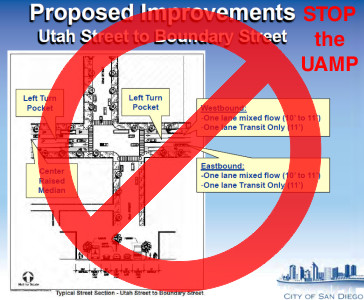
The UAMP was originally developed from 2002-2004 and after years of delays its Environmental Impact Report was approved by the City Council in July 2015, with implementation planned to start in 2018 [1]. The plan includes a number of aspects including adding new crosswalks and raised medians in sections of University Avenue, smoothing traffic flow, and adding and removing traffic signal lights, which are relatively simple changes that could be done at any time. The UAMP then takes things too far however in proposing several unprecedented and unwarranted changes that would greatly reduce pedestrian and bike safety as compared to better alternatives, provide no dedicated bike lanes, greatly reduce parking potentially available on and near University Avenue, and result in long-term negative impacts to the overall comfort, aesthetics, and historic character of the North Park business district and surrounding residential areas.
Summary
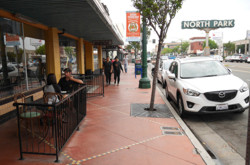
In the following sections we provide evidence, analysis and examples showing that the UAMP in its present form would turn what is now for the most part a comfortable attractive neighborhood avenue into essentially an ugly transit corridor. We also disprove a number of common misconceptions about the plan, discuss how the plan got so far despite its major issues, and provide contact information for our elected representatives and local community groups in the hope that enough residents will rise up, get this message through to city leaders and staff, and fix or stop this plan before it's too late.
Note that the City of San Diego government is currently unwilling to negotiate on the major aspects of the UAMP as they consider it already approved – even though the majority of current residents were not properly notified of its existence or given any opportunity to oppose its design decisions, and despite there being major errors in a number of the assumptions and analyses in the plan [13].
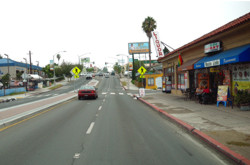
While many claim that since the UAMP was "already approved" it cannot be changed, this is simply not true. The plan's Environmental Impact Report (EIR) is thoroughly flawed, and it is based upon this erroneous and outdated EIR that the plan was approved. All that's needed to stop the UAMP is to file a suit against the city challenging the defects of the EIR. Our discussions with various community leaders – including an expert who has authored other Environmental Impact Reports for similar projects – clarified that the UAMP can indeed be stopped with a lawsuit. While this could likely involve several $1,000 in attorney fees, it could prevent $Millions of loss and damage. Not only would the UAMP be a waste of $6 Million of taxpayer funds, it would turn the majority of University Ave in North Park into a construction boondoggle that would take approximately 1 year to complete, creating a traffic mess and greatly inconveniencing residents, businesses and the general public. Even after project completion, the losses would continue as the aesthetics of our historic avenue would be irreversibly destroyed, pedestrian and bike safety would be significantly reduced in many areas, and residents, businesses and visitors would no longer have nearly the same level of street parking available. Losses to taxpayers, businesses and residents could be well above $20 Million within several years. We hope that North Park residents, business and property owners will take the time to think through what the UAMP would do to University Ave, and work to fix or stop the plan.
Photographic Survey of University Avenue in North Park
To understand the full implications of the UAMP, the changes it proposes should be carefully reviewed and a closer look taken at each block that would be affected. In July 2015 we took nearly 100 pictures showing the extent of University Avenue from Florida Street to 32nd Street, viewable on the pages linked below, in an easy-to-navigate format that can play as a slide show, or flipped through using the on-screen controls or the left & right arrow keys on your keyboard. (Opens in new window, maximize window for best view.)
High Resolution Images (1600x900) | Lower Resolution Images (980x735)
Examples with Street Parking
|
Examples without Street Parking
UAMP Overall Goals and Proposed Changes
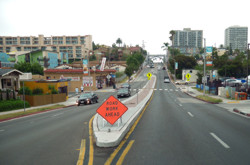
The UAMP claims it will increase safety for pedestrians by calming traffic and by adding and improving crosswalks, and some aspects of it would help achieve these results. The traffic calming features consist of the following:
- Reduce the number of car lanes to one in each direction.
- Add raised medians with left-turn pockets.
- Create one "transit-only" (bus) lane in each direction, that would also serve as a shared bike-lane, and as a right turn lane for cars.
- To make room for the above "transit-only" lane, remove all parallel parking from University Avenue.
- Add additional traffic signal lights at Oregon Street and at Arnold Avenue.
- Optimize placement of bus stops.
University Avenue Issues
University Avenue has some significant issues that can all be addressed with simple approaches. The UAMP in its present state would worsen most of these issues. Current issues on University Avenue can be summarized as follows:
- The lanes are too narrow in some sections, which decreases safety for everyone.
- Cars often stop and block one lane to make left turns, often for a significant amount of time until opposing traffic clears.
- The right lane often becomes backed up or slow due to cars making right turns and stopping for buses and pedestrians.
- As a result of lanes often backing up, cars often make rapid lane changes.
- A quarter-mile stretch between Texas Street and Utah Street has no traffic signal lights. The addition of a signal light on or near Oregon Street would be an improvement for pedestrians and bicyclists.
- Parking has become more constrained over time as more development happens and more residents and businesses move to the area.
- Traffic has gradually become more congested due to increasing density.
University Avenue Advantages
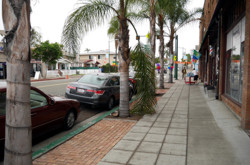
Before proposing approaches to the above issues, the advantages of the present configuration must also be understood. University Avenue is a historic street, used since the late 1800s. In 1907, streetcar lines began to be installed along University Avenue from Hillcrest and up 30th Street from Golden Hill, finally meeting at 30th Street & University Avenue in 1911.
North Park has three primary East-West thoroughfares: University Avenue, El Cajon Boulevard, and Adams Avenue. Both University Avenue and Adams Avenue are the same width, approximately 52 feet in most sections. Whereas El Cajon Boulevard is approximately 108 feet in width, handles approximately 75% more traffic volume than University Avenue [10], and now also includes a rapid bus line that stops at Texas Street and 30th Street [11]. For major North-South thoroughfares North Park has only 30th Street. These thoroughfares all have street parking and primarily commercial and mixed-use zoning. They each have a great deal of historic character and many diverse buildings, shops, markets, restaurants, offices, mixed-use developments, and also a smaller number of houses, apartments and condos.
Street parking is easy to take for granted, but is a major part of why North Park is considered a convenient, comfortable neighborhood, and an integral part of its character and aesthetics, for a number of reasons:
- Provides a buffer between sidewalks and street traffic. Without street parking there is no separation between these. Every time a car or bus drives by a few feet from the sidewalk, dust and dirt are kicked up, water can be splashed from puddles, exhaust fumes and noise are much closer, and safety is decreased [18]. If a car loses control it could veer onto the sidewalk, and pets or children on the sidewalk could more easily run into traffic. Removing this buffer and moving motor vehicle traffic 10 feet closer to the sidewalk would substantially decrease pedestrian safety. The presence of a barrier that diminishes dirt, dust, water, fumes, noise, and provides 10 feet of additional space from moving vehicles, clearly adds to the comfort, aesthetics, and safety of sidewalks. Streets are public property, meant to serve the public in a way that makes things flow as smoothly and safely as possible for the largest number of people. Neighborhood streets should encourage responsible, sustainable principles, accommodating and emphasizing pedestrian and bike traffic, comfort and safety over car and bus traffic.
- Greater visual appeal. This may not be immediately evident or intuitive, but a quick look through the Photographic Survey linked above, or a walk through the neighborhood illustrates this. North Park is a vibrant, progressive community with a large proportion of educated, active residents, and this is reflected in the cars we drive. North Park residents tend to drive fuel efficient, relatively compact cars including many zero-emissions vehicles, and tend to prioritize sustainability, efficiency and environmental responsibility, driving only when necessary. Our cars actually add appeal to a street that without them would be a barren corridor of asphalt and red-painted curbs.
- Provides convenience for residents, local businesses, and visitors to the area. Over 90% of people drive and thus available parking is a primary factor in convenience and accessibility. While this may seem like a minor point on paper or to those who do not drive, this is actually a significant issue relating to comfort, convenience, decreased stress, decreased traffic and pollution, and decreased safety. All it takes is a trip by car to denser areas and spending 15 minutes driving around looking for parking to see these effects in action, and for it to be clear that when practical, ensuring an appropriate level of parking is available to support a community should be a priority in city planning.
- Saves time, reduces traffic and pollution. When sufficient parking is available to accommodate residents, businesses and visitors, this saves everyone significant time – easily several minutes per day × thousands of people. This can easily add up to 50,000+ person-hours of time per year, that people could instead be doing something more productive, such as enjoying the neighborhood, exercising, supporting local businesses, or spending time with friends and family.
- A street parking buffer reduces the width of the active roadway, thereby decreasing the time that pedestrians spend crossing active traffic lanes and reducing the incidence of pedestrian collisions. The likelihood of pedestrian accidents tends to increase linearly in proportion to active roadway width. A narrower active roadway also serves to calm traffic and thereby further increase safety for all users.
One of the primary reasons people live in North Park is because of its walkability. According to walkscore.com, 92104 is the 2nd most walkable zip code in San Diego. It's possible to do quite a lot without a car in North Park, and its walkability puts us way ahead of other San Diego neighborhoods. Residents do need to travel outside of North Park from time-to-time however, or even just to the other side of the neighborhood, which is usually much more practical by car, particularly for families or groups, or when transporting bulkier items such as groceries, home and gardening supplies, tools, equipment, surfboards, etc.
An even more significant reason why people live in North Park however is its relatively low density. Downtown San Diego has better walkability, but is too dense for the tastes of North Parkers, who don't want that level of traffic, noise, and lack of parking, or to live in a high-rise with no yard, no trees or grass, less privacy, and higher costs for less space.
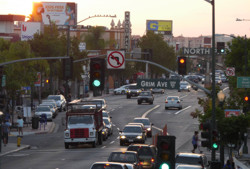
North Park has been a popular, expanding, and continually improving community for close to a century primarily because of its optimal mix of walkability, convenience, central location, historic character, and relatively low density.
North Park also has a unique architectural style with many Craftsman homes and commercial properties ranging from Art Deco to Modern in style. These styles emphasize a connection to nature, building with the land and integrating smoothly with the environment, with low horizontal lines, and significant attention to trees and landscaping. This is reflected in University Avenue, which has very few buildings more than two floors in height, and where sidewalks tend to be wide with trees, planters, benches, and bike racks.
Options for Addressing Current Issues
Current issues with University Avenue can be solved simply by going from four to three traffic lanes [14] – as is now the configuration on 30th Street and Adams Avenue. Having one lane in each direction plus a shared center left-turn lane, optionally with raised medians and left-turn pockets is a common configuration throughout San Diego and other cities. This approach for the middle lanes is similar to what is proposed by the UAMP, but it is not also necessary to go to the extreme of removing all parallel parking. The ratio of the number of buses on University Avenue to cars is low, particularly during peak traffic times; considering that less than 10% of University Avenue commuters use the bus and that buses hold about 10 or more times as many people as cars, this implies that there are about 50-100 cars for each bus on University Avenue, particularly during peak traffic times when the number of cars is higher. Analysis of University Avenue Bus Traffic Volumes and SANDAG traffic count data [10] reveals that the average ratio is actually 74 cars for each bus. Thus to create a bus-only lane, when buses comprise less than 1.4% of vehicle traffic, would not make nearly enough of a difference in travel times to justify such a major change.

With fewer lanes and a raised center median, traffic can flow more smoothly and calmly – if the volume of cars is not so high that gridlock results. Drivers will maintain a more consistent speed, make fewer lane changes, and drive more slowly and carefully due to the presence of the nearby raised median. Thus it seems plausible that reducing the number of car lanes may be a good change to make in some or all sections of University Avenue, with probable exception of East of 32nd Street which has the highest traffic counts and where traffic at peak times already backs up multiple blocks.
The traffic level on the less busy sections of University Avenue seems low enough that one lane in each direction (with separate lanes or pockets for left and right turns) would not cause an undue increase in traffic at most times. However, no evidence has been provided showing that Level of Service criteria were properly analyzed in the UAMP. Ideally the same consultant (Kimley-Horn and Associates) who did the traffic analysis for the much more recent Community Plan Update [2] (which is separate from and apparently in conflict with the UAMP) could be contracted to provide a more current analysis of the UAMP's proposals and alternative approaches. Note that the Community Plan Update's recommended changes to University Avenue seem much more sensible, would cost much less, and would not remove any significant amount of parking. It remains to be determined why the UAMP and the Community Plan Update propose completely different approaches for University Avenue, and why the changes proposed in the much older UAMP are not mentioned in the Community Plan Update.
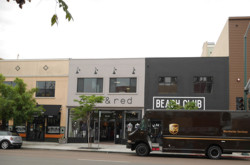
The more minor parts of the UAMP such as adding/improving crosswalks, and optimizing the timing of traffic signal lights are simple and inexpensive changes that would likely have no significant side-effects. However, the removal of all parallel parking, is where it becomes what would be disastrous for the future of University Avenue and for North Park as a whole, for more significant reasons than just convenience. Those who support the parking removal aspect of the UAMP are likely not aware of the true magnitude of the impacts that would result, and are unaware or take for granted the above mentioned numerous benefits that a street parking buffer provides, including greatly improved pedestrian safety. Anyone with any doubts on this should take a look at the pictures linked above, take a walk along the length of University Avenue, and imagine how different the street and sidewalks would look with no parked cars, no separation between sidewalks and traffic, and nothing but red-painted curbs from Park Boulevard to the 805.
Analysis of the UAMP
As discussed above the UAMP's proposal to reduce the number of traffic lanes to one in each direction (which are no longer frequently backed up due to cars stopped making turns) would likely be an improvement that would calm traffic and improve overall safety. This is not an uncommon approach and is what we have on many other San Diego streets such as Adams Avenue, 30th Street, and sections of University Avenue outside of North Park. However, the UAMP's proposal to remove all parallel parking and create bus-only lanes would be completely unprecedented – there is no similar area in San Diego where this has been done. This aspect of the UAMP would be a poorly devised experiment that would destroy the neighborhood feel and historic character of University Avenue.
The UAMP's claim that lost parking would be offset by parking on side streets is thoroughly misleading, and a classic logical fallacy. Parking gains on side streets can be made at any time, independent of other proposed changes. Retaining all or most existing University Avenue parking will ensure North Park can adequately support increasing density and better serve residents and local businesses now and in the future. Increasing parking density on side streets by going from parallel to diagonal parking has already been happening over the past 10 years and helps ensure that enough parking is available to support increasing population density and provide a basic level of convenience and accessibility for residents. Removing nearly 100 spaces would in fact greatly reduce parking that can potentially be made available on and near University Avenue, and greatly impact the nearly 5,000 residents who live within 2-3 blocks of University Avenue.
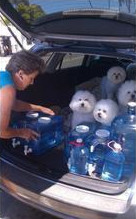
It's easy to take street parking for granted, and proponents of the plan have focused on only the positives of the UAMP while not realizing the extent of the negatives. Many sections of Western University Avenue in North Park already lack street parking, and already look much dirtier and less attractive than those sections with street parking. Before anyone should endorse this aspect of the UAMP they should consider that the entirety of University Avenue would be made to look like what are now its most unappealing sections.
Would proponents of the UAMP would really like all of University Avenue to look like this rather than this? Which of these sets of pictures looks more like a comfortable, attractive pedestrian-friendly neighborhood vs. an ugly commercial corridor? Is it just coincidence that the sections with no street parking all look less appealing and less neighborhood-like than the sections with street parking?
If the UAMP is allowed to go forward unmodified, residents will only then realize too late – after $5.8M was wasted, one full year spent on road work that causes even more traffic and inconvenience, and the street ruined, that the result is in no way an aesthetic improvement, and that the impacts on parking, traffic, and pedestrian and bike safety are all negative. At that point it would be too late and impossible to fix. The UAMP needs to be fixed or stopped now, before it gets anywhere near the implementation stage. The city is making every effort to avoid notifying current residents of the plan and all feedback received indicates they are refusing to fix the worst parts of the plan. (Note that this web page has not been significantly updated since 2018 and unfortunately the city has already now proceeded with this disastrous plan. Thus references here to stopping or fixing it may no longer be practical. This page will remain here as a historic reference.)
Going to three traffic lanes (one lane each direction plus a shared center left-turn lane optionally with raised medians and left-turn pockets) would be a much more practical solution to the constraint of the narrow street width, while also calming traffic and increasing safety for all [14]. This approach would leave street parking unchanged, with possible exception of minor adjustments to support optimization of bus stop placement or possibly removing a small number of parking spaces to accommodate improved right turn lanes.
The only other advantage of the UAMP is that it would reduce traffic for buses. This would be a welcome goal if a large percentage of people used the bus system, or if University Avenue was wide enough to accommodate bus-only lanes without major negative side-effects. However, according to the city's Climate Action Plan document [3] (Appendix B page B-31) the actual bus ridership number is only about 4%. Therefore, to dedicate 40% of the street width to bus-only lanes is not a sensible proposition. We'd all like to do what we can to improve the bus system in San Diego, but making things more dangerous for pedestrians and bikes and ruining the aesthetics, comfort and convenience of University Avenue so that bus travel times would be slightly reduced would be taking it much too far, for a number of reasons that are expanded upon below.
Buses by their nature are designed to be an efficient transport mode relative to cars – but not relative to walking or biking. Many people can use one shared vehicle and thus each have a relatively small environmental footprint, if in fact you have sufficient number of riders. This space efficiency makes them well suited for existing traffic lanes on any type of street, thus to remove all parking along a street so that buses might have exclusive lanes is actually contradictory to their small environmental footprint, when bus traffic counts are very low compared to cars, bicycles, and pedestrians – which is indeed the case on University Avenue, where buses comprise less than 1.4% of traffic volume [15]. Making things worse, bus ridership continues to decline, and many of the large buses seen on University Ave. have only a few people on board. Thus we have a situation where government has provided an extremely expensive, wasteful and inefficient system that is in fact not environmentally friendly. Perhaps this is one reason they seem so eager to force everyone out of their cars – to try and justify the tremendous costs and wastefuleness of the bus system relative to numerous other transportation options.
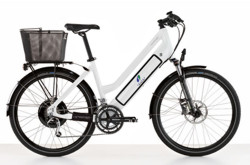
Some supporters of the UAMP claim that speeding up buses will increase ridership, which will benefit the environment in the form of greenhouse gas reductions and less traffic. Responses from the city make clear however that the UAMP would not result in any significant change in emissions [17]. Most would agree that incentives should be provided when practical to make public transportation more efficient, however, a reduction in bus travel times across University Avenue in North Park in itself would not likely increase overall ridership by more than a small fraction of a percent, as there are many other factors that people consider when deciding which transportation options best serve their unique situations and needs. In addition, automotive greenhouse gas emissions have actually been going down for over 10 years [12] and will continue to decline rapidly as hybrid electric cars, smart cars, electric cars, and electric bikes gain further market share. While advances in these areas might seem far off to the unfamiliar or to those who have overlooked the subtle but astounding increase in the number of electric vehicles recently appearing on each and every block throughout North Park, in reality electric cars and electric bikes have both been growing exponentially, with efficiency and performance continuing to increase and costs steadily decreasing. Within 15 years, 90 percent of cars will likely be zero-emission [7 - 9].
An additional traffic signal light proposed by the UAMP at Oregon Street might help to calm traffic and increase safety, and removing the traffic signal as proposed at Ohio Street is probably a good idea due to it being less than 200 feet from another signal light at Grim Street. The UAMP's proposed addition of a traffic signal light at Arnold Street would be excessive however, as there would then be 3 blocks in a row (Oregon St., Arnold Ave., Texas St.) with traffic lights, resulting in cars being backed up such that they would not have even started moving through one light before the light a block away turned red. Arnold Avenue also has very little traffic thus a signal light there seems highly unnecessary.
Disadvantages of the UAMP
The UAMP was created over a decade ago in which time there have been major changes in North Park, in transportation technology, and in related planning goals. Numerous North Park residents, property owners, business owners, and community leaders feel that its assumptions, data, and analyses (and those of its Environmental Impact Report) do not properly account for these changes, and that the major changes it proposes are unnecessary, unjustified, and would have a disastrous impact on residents, motorists, bicyclists, and local businesses. More specifically the UAMP would:
- Remove an important buffer between traffic lanes and sidewalks where parallel parking is currently present, thereby reducing pedestrian safety and degrading the aesthetics, historic character, convenience and liveability of the neighborhood. While it might be easy to fall for the UAMP's claim that lost parking would be offset by gains on side streets, a quick look through the Photographic Survey linked above reveals the stark contrast that would result along dozens of blocks of University Avenue where parking would in fact be removed. Parked cars make a significant positive difference in nearly every case.
- Prevent North Park from being able to keep up with steadily increasing density by removing all parallel parking on University Avenue, which would not be significantly offset by parking gains on side streets. The UAMP's claim that lost parking would be offset by parking on side streets is thoroughly misleading. Parking gains on side streets can be made at any time, independent of other proposed changes. Regardless of sleights of hand, the removal of nearly 100 parking spaces would in fact greatly reduce the amount of parking that can potentially be made available on and near University Avenue, and would inconvenience not only businesses and their customers but also 5,000+ residents who live within 2-3 blocks of University Ave.
- Make things more dangerous for bicyclists due to including no dedicated bike lanes. Expecting bikes, buses, and cars turning right to share the same lane would create a number of issues and is unprecedented in other urban street designs. This would be a huge step backward for bike safety as compared to more sensible configurations such as those of 30th Street or Adams Ave.
- Result in ugly medians with no landscaping (West of Arnold Ave) due to the city being unable to budget a relatively minuscule amount for landscaping, while also not complying with the city's Climate Action Plan which requires a minimum tree canopy area to be provided in public projects. [3]
- Reduce safety on side streets. The UAMP proposes going to head-in parking on some side streets, but this gains only a small number of spaces at the expense of making the streets narrower and visibility worse, which will increase the number of accidents. Earlier in 2015, Illinois Street and Iowa Street were converted from diagonal to head-in parking on one side of the street, and both now look more like strip-mall parking lots. Parking used to be simple and straightforward with no need to block opposing traffic, but now with spaces at a 90 degree angle both traffic lanes are blocked whenever someone pulls in or out of a space. In addition, the use of head-in parking on streets of this width usually results in a net loss of available parking as compared to diagonal parking because there is only room for head-in parking on one side of the street, leaving parallel parking as the only option for the other side. Kansas Street for example has diagonal parking on both sides of the street, which can gain 5% or more potential spaces [16] with better visibility and safety vs. the UAMP's new and unprecedented scheme to install head-in parking on one side only.
- Create more traffic during peak times on many parts of University Avenue by reducing car traffic to one lane instead of what is now two lanes in each direction along most of University Avenue. This would be significantly mitigated by the presence of separate turn lanes, but no evidence has been provided on what Level of Service impacts would result along various sections of University Ave.
- Realize no environmental benefits. Responses from the city make clear that the UAMP would not result in any significant change in emissions [17]. In addition, adoption rates of zero emissions vehicles have been far outpacing state and local goals and estimates used to justify bus-only lanes. (The city's Climate Action Plan grossly underestimates electric vehicle adoption rates and contradicts itself [3] (Appendix B pages 12 and 27) in saying that increased bus ridership is needed to reduce CO2 emissions, while acknowledging that 90% of the city's own vehicles will be zero-emission well before then.) Fossil fuel cars will all but disappear off new car dealer lots by 2035, particularly in California, one the world's top clean-tech innovators and adopters [12]. In addition, buses are still impractical for approximately 95% of residents. Telecommuting and virtualization will allow people to commute less in the future, reducing the need even further for buses and cars; And with smaller, cheaper electric car and bike options it will be more practical and less expensive for many people to go with an electric bike rather than pay $1,000 per year for a bus pass. Therefore, the bus system will likely lose further ridership share over time, while automotive emissions literally disappear. [7]
- Fail to encourage the use of bicycles and electric bicycles as a practical transportation option. We need dedicated, protected bike lanes throughout San Diego, that make it possible for bicyclists to get anywhere in the city in a guaranteed safe manner – where they are not subject to getting hit by a car any time a driver is not paying attention or has impaired visibility. The world is transitioning towards greener, healthier, more active modes of transportation and San Diego is far behind most other leading world cities in this area. Only when bicyclists are made a first-class priority and given the level of safety they deserve will bicycle use will start to greatly increase – with corresponding reductions in vehicle traffic and increased quality of life for everyone. Until then the reality is that many people will not seriously consider a bike or E-bike as a transportation option that they will actually make significant use of.
- Violate the recommendations and intentions of the city's Community Plan Update, which recommends practical and sensible changes that would reduce traffic and significantly improve University Avenue for a vast majority of users. [2]
Project Status
The plan's website as of August 2015 lists the following schedule:
The design is anticipated to be completed in December 2016. After California Department of Transportation construction authorization is obtained, the project is anticipated to start advertising in March 2017. Construction will start approximately six months later, and is anticipated to last 12 months.
We also received the following email from the city's Engineering Dept. on Aug. 19, 2015:
Thank you for your email regarding the University Avenue Mobility Project (UAMP). The Environmental Impact Report (EIR) prepared specifically for UAMP was approved by City Council July 27, 2015. The EIR was prepared in compliance with the California Environmental Quality Act (CEQA) and disclosed significant impacts to the project boundary as a result of the proposed improvements. Opportunities for residents and businesses to comment on the EIR, and project scope outlined within, included the scoping meeting, public review of draft EIR, period for appeal of final EIR, and attendance at City Council when the project was an agenda item. Representatives of the North Park Planning Committee and North Park Main Street attended the City Council meeting, were in opposition to the appeal of the final EIR, and affirmed their commitment to the project. With the City Council approved EIR, City Staff is now working to hire a design consultant to implement the improvements (or project scope) listed specifically in the EIR. Once a consultant has been brought on board the City Staff will attend a North Park Planning Committee meeting to kick-off the design phase. Throughout design City Staff will work with both the North Park Planning Committee and North Park Main Street to keep residents and businesses informed of design decisions and status. Please be sure to coordinate with these community groups regarding how you can be involved during the design phase. Thank you, Jayna Straughn, PE Associate Civil Engineer City of San Diego | Public Works Department Right of Way Division | Transportation Streets
All North Park residents are urged to coordinate with community groups, contact University Avenue business and property owners and residents to spread awareness, start petitions (e.g. on www.change.org), and follow any available legal and political processes to fix or stop the UAMP.
References & Additional Information
- City of San Diego University Avenue Mobility Project
Links to the Project Features Map pdf, Information Sheet and Presentation. Note that of the goals touted in the Information Sheet and Presentation document, very few would actually be achieved by the plan. - City of San Diego Greater North Park Community Plan
The 2015 San Diego Community Plan Update goes into extensive detail and analysis of current transportation and traffic conditions on University Avenue as well as all other major thoroughfares in North Park and surrounding communities. The plan recommends a significant number of common sense improvements, each with detailed traffic count data and analysis based on standardized Level of Service (LOS) Criteria for Intersections. The changes recommended do not have any of the disadvantages of those in the UAMP, and are a much more sensible approach to improving University Avenue. - City of San Diego Climate Action Plan (CAP)
- North Park Planning Committee Agendas and Minutes
- North Park Main Street
- San Diego Union-Tribune Article July 27, 2015
- The Clean Vehicle Revolution: Driving Fuel Savings and Emissions Reductions in the United States
- Article: Electric Car Sales Have Doubled Every Year For Three Years
- San Diego Reader: Who Is Riding Electric Bikes These Days?
- SANDAG Traffic Volume Data
- Voice of San Diego: Rapid Bus Isn't as Rapid as Everyone Hoped
- Article: California Redoubling its Push for Clean Energy?
- Letter to City Leaders from a University Avenue Business Owner and NPMS Board Member, July 1, 2015
- Street Profiles Proposed by the UAMP vs. The Community Plan Update
- University Avenue Bus Traffic Volumes
- Potential Parking Density
- UAMP Final EIR Response to Public Comments
- Article: The Simplest Way to Avoid Bad Street Design: Copy the Ones That Work
Further Discussion & Analysis
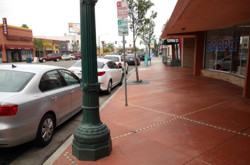
The UAMP was developed during a different era in North Park. The core commercial district of North Park has changed tremendously in the past 10+ years. Density continues to significantly increase as major new mixed-use developments continue to appear, from the Boheme Condominiums on 30th St. 1/2 block from University Avenue adding 224 condos in 2006, to the Iowa Street Senior Housing project (also 1/2 block from University Avenue) adding 120 apartments in 2016.
To disrupt the community now with an old plan that would tremendously alter North Park's character, would be a waste of $5M+ that would preclude better options such as dedicated bike lanes, more optimal use of available road space, and a level of convenience necessary to prevent University Avenue from becoming a typical big city corridor with insufficient parking and little of the style and comfort that has helped support North Park's transformation over past decades. At the time the UAMP was originally drafted, North Park was still considered a run-down area that was to be avoided after dark, with many old buildings in disrepair, and nowhere near the number of high quality businesses and developments that now exist in the business district along University Avenue and 30th Street. No street parking and bus-only lanes might not have looked so out-of-place back then, but today North Park has seen nearly every old building renovated and revitalized and has transformed into one the nicest and most appealing urban areas in San Diego. Because these changes happened gradually they may be easy to overlook.
According to [13] (Page 2 Item 2), the UAMP "relies on a 2009 parking study to identify and quantify the parking needed to replace the parking removed from the business district. This ... study is surely out of date and doesn't reflect the current situation on the ground in North Park. For instance, the study mentions that current street parking, at its highest, is 61% utilized. Anyone who has been in North Park at any time of the day knows that this is a laughable figure. In addition to the inaccurate information in the parking study, the mitigation effort also sited parking far from the most affected areas. This parking is, for the most part, blocks away from the central district and has already been absorbed by the residential parking population. Many of our businesses need short-term, close-by parking to survive. Imagine each and every business on University Avenue now being dependent on customers parking blocks away and walking a significant distance with bulky items or just needing to make a quick pick-up or drop-off. Businesses will die on the vine. Even the parking garage (which has been much higher utilized than projected) doesn't solve this issue. It is great for longer-term parking, but is ineffective for short-term needs."
North Park residents are strongly encouraged to contact the Public Works Department, City Council members and staff, the Mayor's office, and community groups as soon as possible to share your concerns and make it clear that we will not stand for losing all parallel parking on University Avenue, having the whole length of the street turned into an ugly asphalt corridor, while safety and comfort are greatly diminished for both pedestrians on the sidewalks and cyclists for whom no dedicated bike lanes would be provided.
The UAMP brings to mind the decline of North Park in the 60's when malls became the new convenient destinations and older urban areas went into a long decline that did not finally reverse until relatively recently. While additional parking has been added to side streets, this would not entirely offset losses on University Avenue, particularly in some sections and for businesses who depend on pickups and deliveries, where it is not practical to cart merchandise such as furniture or equipment for blocks along the sidewalk. These are not just random spaces in a parking lot. They are each a part of the neighborhood and have stood undisturbed for over a century.
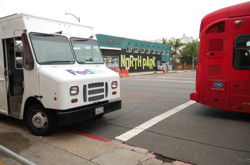
With as bad as this plan is in light of the evidence presented here, it could be presumed that the plan was simply the result of a bad design, done at the wrong time. As with many projects of this sort however, once "experts" have been hired and time and money have been spent, it's easy for the proponents to have a confirmation bias and to ignore contrary evidence. Making things more inconvenient and dangerous for everyone for no other reason than to give a small number of buses their own dedicated lanes is a bad idea, proposed at the wrong time, in the wrong place.
That the UAMP has proceeded as far as it has is understandable given past context. People looked at the overall package, saw the advantages, saw the existing issues on University, saw an opportunity to be a model for supporting the bus system, trusted that the city had done proper due diligence, did not closely review the plan's assumptions or data, and concluded that it looked like a good overall concept. In the early 2000's, University Avenue was run down and not so neighborhood-like. It was indeed more a transportation corridor than a gentrified neighborhood. Thus it's understandable how the UAMP came about at that time. But if the community now takes a fresh look at things in what is now a very different context, examines what the impact of the UAMP would be now, reviews and compares the example pictures provided here or visits each block that would be affected, and looks at better alternatives, it becomes clear that the proposal to set aside 40% of the road area for buses is simply not appropriate for University Avenue.
Many local businesses depend on a basic level of street parking to conduct business and remain competitive with other areas. A substantial loss of available parking would drive many businesses away from University Avenue, increase vacancies and decrease property values. The significance of such inconveniences is even greater when social and psychological factors are considered. In going from being able to generally park within one block of most businesses and residences on or near University Avenue, to then having to park several times as far is a significant psychological barrier, not necessarily to everyone but certainly to those to whom convenience is a priority when deciding where to shop, dine, or meet up with friends and co-workers. An example of this is reflected in feedback on the North Park Parking Garage. Though the garage is a good resource, feedback indicates that most people avoid it and will sooner drive for blocks looking for street parking or take their business elsewhere, than deal with paying for parking, navigating the large structure, and walking multiple blocks to their final destination. It's easy to blame drivers for preferring convenience, but this would not change the fact that 90-95% of North Park residents, commuters, and visitors would be greatly inconvenienced by the UAMP and would then tend to look to other areas when deciding where to live, work, shop, go out for dinner, or even just go for a walk.
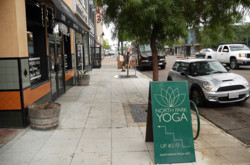
Walking is also much less appealing on a barren road with buses driving by 2 feet away from the sidewalk, than on a neighborhood-oriented street like 30th Street, Adams Avenue, or the majority of University Avenue as it now is. The UAMP would actually drive away pedestrians and bicyclists – despite its claim to do the opposite.
With the limited road width and relatively high density in the core neighborhood commercial section of University Avenue between 28th Street and Bancroft Street, in finding a trade-off between safety, comfort and convenience, and travel times, travel times are indeed the lower priority. The safety and comfort of residents, pedestrians, cyclists, and motorists has to be the top priority. Providing sufficient parking to serve the large number of motorists and the large number of small independent businesses, maintaining North Park's historic style and character, and maintaining safe and comfortable sidewalks are each more important than carving out bus-only lanes in the hope of reducing bus travel times by a couple of minutes or smoothing bus traffic, which comprises less than 1.4% of vehicle traffic and which can leverage far-side bus stop placement and queue jumps to achieve similar results [2, 15].
Encouraging more people to take the bus is a worthy cause and the bus system works well for many use cases, but unfortunately it is often impractical for those who need to make a number of stops or travel large distances that may not be conveniently located near various bus lines. Bus ridership is unlikely to ever exceed 4% of users of University Avenue, and creating bus-only lanes on such a narrow street would do more harm than good. In addition, many North Park businesses serve customers from all over San Diego County, a majority of whom live in places where travelling to North Park by bus would literally take hours. With an area of 4,526 square miles, San Diego County as a whole is not well served by public transportation. Two thirds or more of customers of North Park businesses likely drive to the area, and the success of our diverse range of high-quality local businesses is key to North Park's continued vibrancy.
Conclusion & Recommendations
The above listed unwarranted, unprecedented, and inappropriate changes proposed in the UAMP should be unequivocally removed, and that until this occurs every effort should be made to Stop the UAMP by any legal and political means. Once these disadvantages have been removed from the UAMP, the remaining proposals could yield significant improvements to University Avenue.
We would also recommend that the North Park Community Plan Update recommendations move forward, and that any future changes proposed to University Avenue only be done with adequate and timely notification and involvement of the community and all residents, with proper substantiating data and analysis provided by the city and its consultants during this process. We also suggest that any major changes proposed to University Avenue be subject to the same analysis and review as were changes recommended for University Avenue in the Community Plan Update.
Community Comments / Feedback / Suggestions
David R., former MTS bus driver: Thank you for taking the effort to write up those reasonable thoughts. Hopefully it's not too late to put a stop to this wasteful and harmful plan and implement something better. (That image from the North Park Community Plan* looks good to me.) As a former MTS bus driver, I completely agree that buses do not need dedicated lanes on University Ave. Even putting aside the fact that buses account for a trifling 1.4% of traffic on University, equally important is the fact that dedicated transit lanes would provide quite little benefit yet have a very great cost. The reason buses are slow has very little to do with other traffic. Buses are slow mostly because of the time it takes to stop at so many bus stops and wait for passengers to get on and off the bus (a large percentage of whom are elderly, disabled, homeless carting around their possessions, not ready with their fare, attempting to ride for free and unwilling to disembark when denied a free ride, etc.). Some of this is through no fault of the riders; some is. The point is simply that buses will not run much faster with a dedicated lane. Not in this ex-driver's estimation, at least. As an avid cyclist, I agree that a dedicated bike lane is much preferable to having to look over my shoulder constantly, wondering if a bus is coming up behind me (which I experienced when riding in these types of lanes when I lived in San Francisco). And as someone who enjoys walking North Park, I agree that it's nice to have a buffer of parked cars separating myself from the noise and danger of moving cars (something I had never considered before; good point). The costs to local businesses and residents make the loss of that parallel parking doubly painful. Something definitely needs to be done about University Ave., particularly the installation of a bike lane - which benefits not only cyclists but drivers as well, as it is much less stressful and inconvenient to pass a cyclist when both car and bike each have dedicated lanes. Something needs to be done, but the UAMP isn't the answer.
David R., former MTS bus driver: I feel like people are thinking of this in terms of "Do I support alternative transportation and lifestyle habits other than cars? Then I must support the UAMP. After all, it seems to be de-prioritizing cars." It's really not that simple. The UAMP is indeed de-prioritizing cars, but it's also harming other groups. The UAMP is a loss for cyclists (who could actually have a *dedicated* bike lane). It is a loss for pedestrians (who will no longer have a buffer of parked cars partially protecting them from the noise and danger of moving traffic). It is a loss for University Ave businesses and their customers. University Ave is absolutely in need of a revamp. I ride my bike on it multiple times each week, and every time I fear significantly for my safety. That doesn't mean that the UAMP is the right revamp plan. We can put our $5.8M to better use. The better alternative discussed on northpark.us and in the North Park Community Plan is a solution that, like the UAMP, de-prioritizes cars. It prioritizes biking even more than the UAMP by giving bikes a dedicated lane, rather than forcing bikes to share with buses, and this alternative plan accomplishes these goals with a less negative impact on businesses (lost parking spaces) and pedestrians (lost buffer of parked cars). In my opinion, the UAMP is not the best way to accomplish these goals. It compromises almost all other interest groups for the sake of providing special lanes for buses, which (as a former MTS bus driver) I can tell you will still not make bus transit much faster or more pleasant. The UAMP simply doesn't strike the right balance. Let's put our tax dollars to the best use possible.
Mike F.: I recently had a conversation with someone from Todd Gloria's office. I asked questions about what the status of the plan was, the validity of the plan considering it has take a long time to implement and what to expect. Here is what I picked up: The UAMP is currently being developed. Although there have been setbacks as far as time frame for implementation, it is moving toward being done. Part of the setback has been to allow for North Park to create a PBID (property owners improvement district) that could fund maintenance and beautification along this corridor. Although, it was also felt that those funds could still come from NPPC or MAD funds. The plan also had to take into account an EIR that is complete now. The plan is only at 30% design completion according to the representative that I spoke with. There is only an overlay of what the plan would look like, but it is far from done. According to our conversation though, the plan to have dedicated transit lanes is basically a non negotiable thing. They are now looking into where the best locations would be for traffic lights, pedestrian crossings and the best way to implement those types of things. Gloria's office agrees that there needs to be more information regarding the plan available to the public and they are requesting that from the city.
Paul J.: In Hillcrest the Parking District said any new head-in spaces (145 identified) could not be used to "mitigate" spaces lost on University Ave. The business district then successfully lobbied SANDAG to keep the parking spaces.
Richard K.: When travelling Westbound on University left turns can be made on 32nd and 30th, but nothing in between. I think another left turn between the two streets should be allowed.
Sean M.: Bus lanes are a waste of space 90% of the time that sits empty and unused until the bus comes. Automobile lanes are almost always being used. In my view a lot more drivers would be inconvenienced by the bus lane than bus riders who would benefit from a slightly faster bus trip. Thousands of cars would idle and inch along while getting passed by dozens of half-empty buses.
Sean M.: I have always suspected that bids to restrict road access to private motor vehicles are intended to reduce carbon footprint, but the obvious effect of the resulting gridlock would be increased pollution from idling vehicles. I recommend that those who think gridlock will reduce motor vehicle use consider Los Angeles and Orange County.
Steve B.: Traffic on university directly in front of my business has increased significantly in the last five years. So much so that I often avoid University Ave altogether. Eliminating an entire lane (reduction of 50%) in both directions would create a traffic nightmare.
Riley G.: No bike lanes? As if cyclists don't have it tough enough already. And I can only imagine how bad the traffic would be while construction is going on.
Max C.: We don't want awful hard-scape pink stamped medians all up and down University. Contact a designer to create a beautiful street with landscaping. Please do not do this insane one car lane. This would increase traffic, and reduce quality of life.
Vernon F.: This plan was ill conceived and is certainly outdated. This scheme would have a negative impact on the liveability we have worked so hard to re-establish in North Park. Bike use, now just treacherous, would be doomed with this arrangement, and walkability would suffer with no buffer. Medians would be a huge mistake and would waste 20% of the existing narrow roadway. Dedicated bus lanes are also dead-wrong: 50% of the roadway would be empty 95% of the time. Consider this: The curb-to-curb street width is only 52' along much of this segment, just wide enough for a section like this: 6'|10'|10'|10'|10'|6' (bike|car/parking|car|car|car/parking|bike). The bike lanes are the sidewalk buffer. Restrict left turns. Raised crosswalks at key locations calm traffic and eliminate the need for new signals. This is done elsewhere with spectacular results. The traffic planners and engineers behind this need to travel abroad or even just to Portland and see how the rest of the word elegantly deals with cars, bikes and pedestrians. The city of Copenhagen, on streets generally this width, put bike lanes where parking was (against the curb/sidewalk), slid parking over into what was the right lane, and left 2 lanes for traffic, 1 each way. This began in the 1980's and today 45% of the population commute on bikes.
Sonya S., Owner, The Water Lady, 2527 1/2 University Ave.: We sell water, which is bulky and heavy. It is not practical to transport multiple 5 Gallon jugs to distant parking spaces, or by bicycle or bus. We have a high volume of frequent customers who pull up 7 days a week to get their water. We love North Park but the UAMP is out-of-control and not business friendly. And to not get any feedback or communications from our representatives is disappointing and a slap in the face after all the tax revenue I pay. I did not get anything in the mail about the UAMP and I pay every year to be part of the Business Improvement District. For what? I've spoken to David at Animal House pet store and he and several other businesses said they went to the meetings where they were told this whole thing is a done deal and no sense in trying to change it. It would be interesting to interview the businesses that were impacted by the UAMP already at Alabama Street. They added a median there and removed the street parking over 1 year ago*. Several of these businesses then sold or closed down. The City might as well just notify the businesses along University Avenue that the new structured plan is for beer bars, foot traffic and bike friendly businesses only, all other businesses have 90 days to Move Out! This is how they are treating established businesses who helped grow the community all these years.
Trenton R., SD City Homes, 2828 University Ave.: The drastic reduction in street parking would limit the types of business that wish to locate and operate in our commercial corridor. The last thing we want is a district made up solely of entertainment venues, to the detriment of small retail and service establishments. This plan could amount to, in my opinion, the taking of value of private property and business owners through city action. ... This is NOT beautification of our neighborhood and community members will not stand for turning University Avenue into a desolate cement runway for buses. ... I, like most of the stakeholders in our business district, want to see a green, walkable, bike-friendly, business-friendly environment. We also want to see small, daytime businesses succeed. They are the lifeblood of a business district. Many of these businesses need short-term, close-by parking. We should be able to accommodate a good mix of businesses and reach all of those goals. I ask that you please delay the docketing of the UAMP until its three main problems (No notice provided to current stakeholders; Loss of all parallel parking; Lack of any landscaping on new medians) are addressed satisfactorily.
Dalour Y.: My building at Alabama Street has four businesses including a convenience store that has been in existence prior to World War II. These businesses rely on seven street parking spaces in front of the building for the majority of their business. The UAMP calls for the removal of all these spaces. Parking is and always has been a major issue in North Park and this corner is no different. The removal of these parking spaces would not contribute to safety or walkability and would likely result in the demise of these businesses. Our area has its own share of blight and my wish is not to add my building to the list. I strongly encourage the City to revisit this issue.
Contacts / How You Can Help
Stopping the UAMP will only happen if enough North Park residents contact their representatives and demand that the UAMP be put on hold and not be allowed to proceed any further, until all its issues have been adequately addressed to the satisfaction of a majority of current North Park residents. Please contact the below groups, and help spread the word to North Park residents to encourage others to do the same. Be sure to also follow up on all emails, calls, and social media postings and demand that meaningful actions be taken, and ask what other steps you can take to help get these issues fixed.
City of San Diego Public Works Department
San Diego Councilmember Todd Gloria Council District 3
San Diego Mayor Kevin Faulconer
North Park Community Association
Feel free to contact us with comments, feedback, or suggestions on what you like, don't like, or would like to see changed in the UAMP, ideas for better alternatives, or how to best get the word out to the community. Please send emails to info at northpark dot us, and be as specific as possible and provide references or evidence to strengthen your suggestions and comments. Note however that the most important thing is to contact your representatives and community groups.
Example Letter to Government Agencies, Community Groups and Elected Representatives
At the request of several residents we have provided below an example letter that summarizes the issues with the UAMP along with the email addresses of the above groups:
Example Letter (PDF file format)
Example Letter (RTF file format)
We hope this may be a useful template, but the most important thing is to tell the city government and our representatives and community groups exactly what you want to see changed in the plan. You may be able to communicate that in your own way much better than we have in the above example, thus we recommend using this example letter only as a general guideline. Government and our representatives are here to serve the public, not the other way around. Just because a bad plan was somehow approved based on limited community input from decades ago does not mean that the city government can now ignore residents and ignore common sense.
The burden of proof in justifying the UAMP is on the city government – not on residents. If a significant number of people tell the city that this is a bad plan and propose a better way to achieve the same benefits without the downsides (as we have done here), the burden is then on the city to clearly prove why such an approach is not better, regardless of whether certain aspects of their plan were previously "approved" or not. The amount of community input on this was very limited. The vast majority of residents never received any notification that the UAMP was being planned or that there was a time limit on community feedback. If the city will now simply ignore all such input, it is up to residents to stand their ground and pursue appropriate legal action.
Additional Information
Street Profiles Proposed by the UAMP vs. The Community Plan Update
Below is the street profile proposed by the UAMP, followed by examples of what would be much more appropriate for University Avenue.
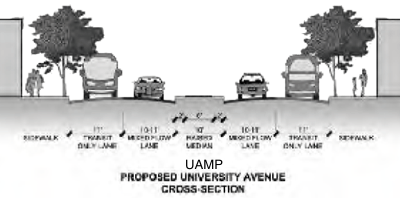
The UAMP documents provide only the low-resolution image above [1]
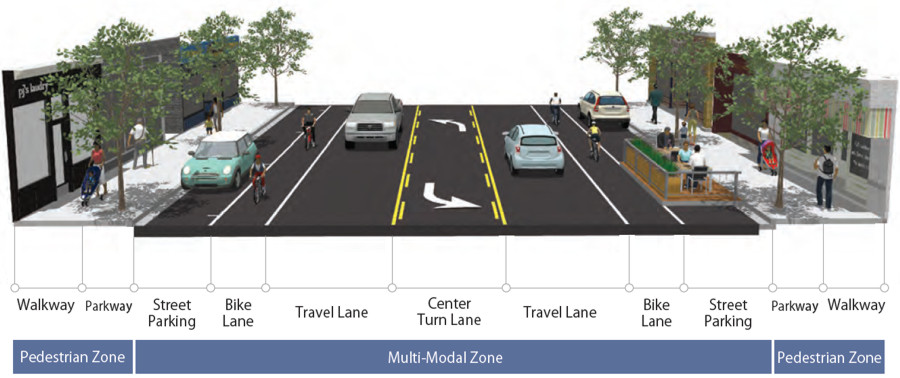
A much better plan for University Avenue. Image from the North Park Community Plan [2]. This common configuration is used throughout San Diego on streets including 30th Street, Adams Avenue, and University Avenue East of the 805, some of which have higher traffic counts than University Avenue in North Park
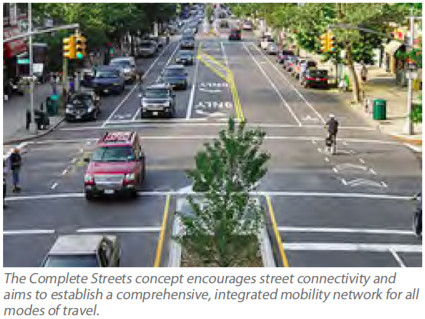
Another example from the North Park Community Plan
The latter two examples are decades ahead of what the UAMP proposes in terms of functionality, safety, and aesthetics. Traffic counts on these streets are similar [10], 21,600/day for University Avenue between 30th and 32nd Streets – vs. 21,100/day for Adams Avenue between 35th Street and the 15, and 24,600/day on University Avenue in City Heights between the 805 and Swift Avenue, the latter of which have 3 traffic lanes, dedicated bike lanes, street parking, no bus-only lanes, and the same overall mix of traffic as in North Park. These examples would clearly accommodate the traffic counts of University Avenue in North Park while having none of the negatives of the UAMP.
University Avenue Bus Traffic Volumes
Bus maps and schedules available on the MTS website show that University Avenue has only two bus routes – the 7 and 10. The number of stops in both directions for both routes totals to an average daily number of 307 buses, which is one bus per approximately 9.5 minutes in each direction, or per 5 minutes in either direction. On weekdays during peak times this number is closer to 17 buses per hour, which is one bus per 7 minutes in each direction. In University Avenue's highest traffic area between 32nd Street and the 805 the average daily traffic count is 22,700 [10]. Dividing this by the number of buses gives a ratio of cars to buses of 74 to 1. In other words, buses account for only 1.35% of vehicle traffic along University Ave.
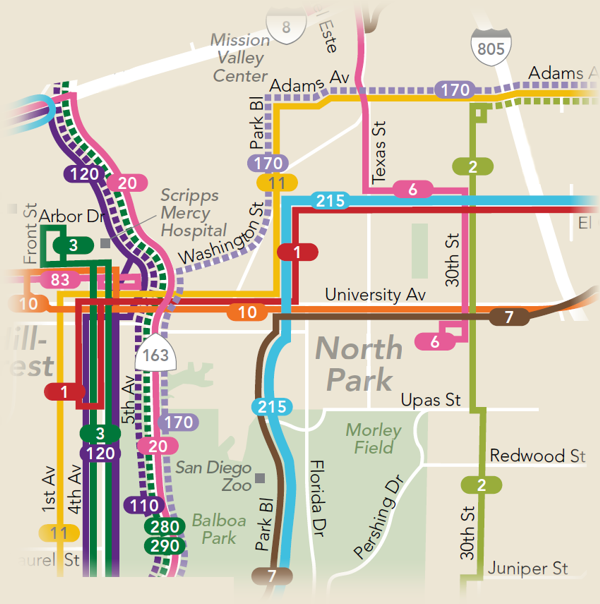
Would it be justified to create bus-only lanes, remove all parallel parking, provide no dedicated bike lanes, reduce pedestrian and bike safety, and turn University Avenue into a barren transit corridor, so that traffic might be slightly reduced for a transportation mode that accounts for less than 1.4% of traffic volume? The UAMP apparently overlooked this data, and its proposals for bus-only lanes, no parallel parking, and no dedicated bike lanes are clearly inappropriate for University Ave.
Potential Parking Density
Relative to parallel parking which typically accommodates 1 car per 22 to 25 feet of curb length, diagonal parking (45°) can accommodate 1 car per ~13'4", and head-in parking can accommodate 1 car per 10'. With a limited road width however it is not possible to have head-in parking on both sides of a street. A block with 500 feet of available parking space on each side and a 52 foot road width can potentially accommodate the following numbers of parking spaces:
| Parking Configuration | Potential Number of Spaces per Block | Gain Relative to Parallel Parking |
|---|---|---|
| Parallel parking both sides | 43 | - |
| Diagonal parking both sides | 75 | 74% |
| Head-in one side, parallel on the other | 71 | 65% |
Comparing streets adjacent to University Avenue such as Kansas Street which has diagonal parking, and Illinois Street which now has head-in on one side and parallel parking on the other, reveals that the former is not only more space efficient but has greatly improved aesthetics, visibility and safety. If one side of a street does not have as much curb length available for parking due to a large number of driveways or loading zones, a parallel + head-in arrangement may be a better fit, but in the case of Illinois Street the side with head-in parking actually has more driveways and less space, thus diagonal parking on both sides would have been much more optimal.
The exact number of spaces that can be optimally fit onto a given street can vary widely depending on a number of factors but it's clear that in all cases diagonal parking on both sides will provide better visibility and safety, and in a vast majority of cases will provide better space efficiency.
Additional Notes
- Under the UAMP, environmentally responsible construction features are almost nowhere to be seen. No significant water recapture is provided and only limited trees and landscaping would be provided between Arnold Ave. and 32nd Street. Parklets would also be impossible. 40% of the roadway area would be dedicated to bus lanes where a bus comes only once per 7 - 10 minutes.

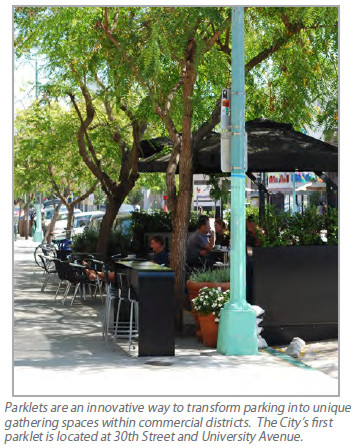
No additional trees or landscaping along sidewalks would be provided, and nothing would be done to improve the overall poor condition of most existing street trees. Expanded green areas on sidewalk parkways as shown in the left image above would not be provided. These could be implemented for a minuscule fraction of the cost of the UAMP and would result in reduced storm water run-off, better water recapture, healthier trees, and eco-friendly xeriscape.
The need for landscaping is clearly demonstrated at the North Parker mixed-use complex on 30th and Upas Streets (shown below), and at numerous other large developments that have nothing more than a few street trees on the sidewalk, where dozens of residents of the building take their dogs for walks who then all urinate in several five foot square dirt patches, creating a nasty stench along the sidewalk in front of the businesses there. This accumulated bio-waste from dozens of dogs each visiting multiple times per day requires a larger, landscaped area for proper remediation to occur.
- Under the UAMP, bike corrals, 15-minute loading zones, and commercial loading zones would not be possible.
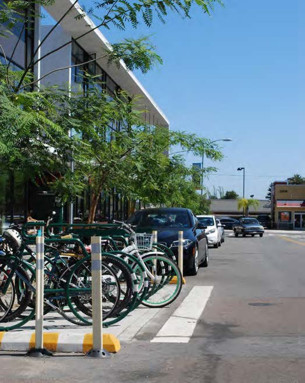
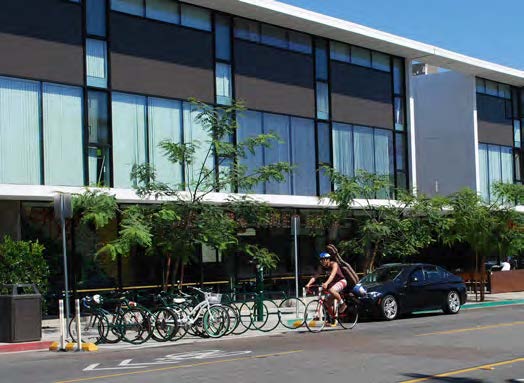
Note that the street pictured is 30th Street – which has a time-proven lane configuration that accommodates all transport modes very well, includes dedicated bike lanes, San Diego's first parklet, and bike corrals. This configuration would be far superior for University Avenue than what the UAMP proposes.
- Under the UAMP, an attractive, convenient neighborhood street would be turned into an ugly transit corridor, which is completely inappropriate for the low (1.4%) bus traffic volume, and would be more dangerous and less inviting to pedestrians and cyclists.
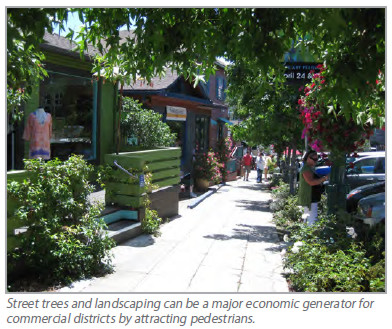
North Park residents can do much better than the UAMP. The UAMP is so thoroughly flawed that trying to fix it would likely waste more time than starting with a new and fresh approach – starting with a full understanding of the current state of University Avenue and North Park, and the awareness that due to the monumental shift now underway to electric cars and electric bikes, buses no longer need to be of overarching priority.
Social Media
The below graphic showing a page from the UAMP PowerPoint presentation with a Stop the UAMP meme overlaid is provided here so that a thumbnail image will appear when sharing this webpage on Facebook and other social media sites. Please share this page (www.northpark.us/uamp/) to Facebook, Twitter, etc. and in messages and emails. #stoptheuamp

About
This page was created by David Gleason, owner of two North Park businesses and CTO of a San Diego satellite communications company. David has been a North Park resident since 1994 and has been an electrical, systems, and software engineer since 1993. David is an advocate of all modes of transportation. He used to race BMX bikes in the 80s, owns an electric bike, rides a skateboard now and then, and frequently walks or bikes all over North & South Park, Balboa Park, Golden Hill, Downtown, Hillcrest, Mission Hills, University Heights, City Heights, Normal Heights, Kensington, Mission Valley and beyond.